A major benefit of homeschooling is having the ability to personalize learning methods and goals and choose unique enriching educational experiences for your student! With its versatility, Kialo Edu is a pedagogical tool that can help you get the most educational value out of homeschooling learning experiences.
Whether that’s a field trip to a local museum, an interesting unit in a textbook, or an educational podcast on your student’s favorite subject, you can use Kialo to reinforce and support learning. Let’s look at how Kialo discussions can fit into your pool of homeschooling resources, and what this might look like in your homeschooling classroom.
Why Kialo discussions are great for homeschooling
Research shows that argument-mapping tools like Kialo are one of the best ways to train students’ critical thinking skills while slotting right into your curricular lessons! Kialo discussions are designed to break arguments down into understandable chunks, helping students explore a complex topic or problem from different perspectives in great detail.
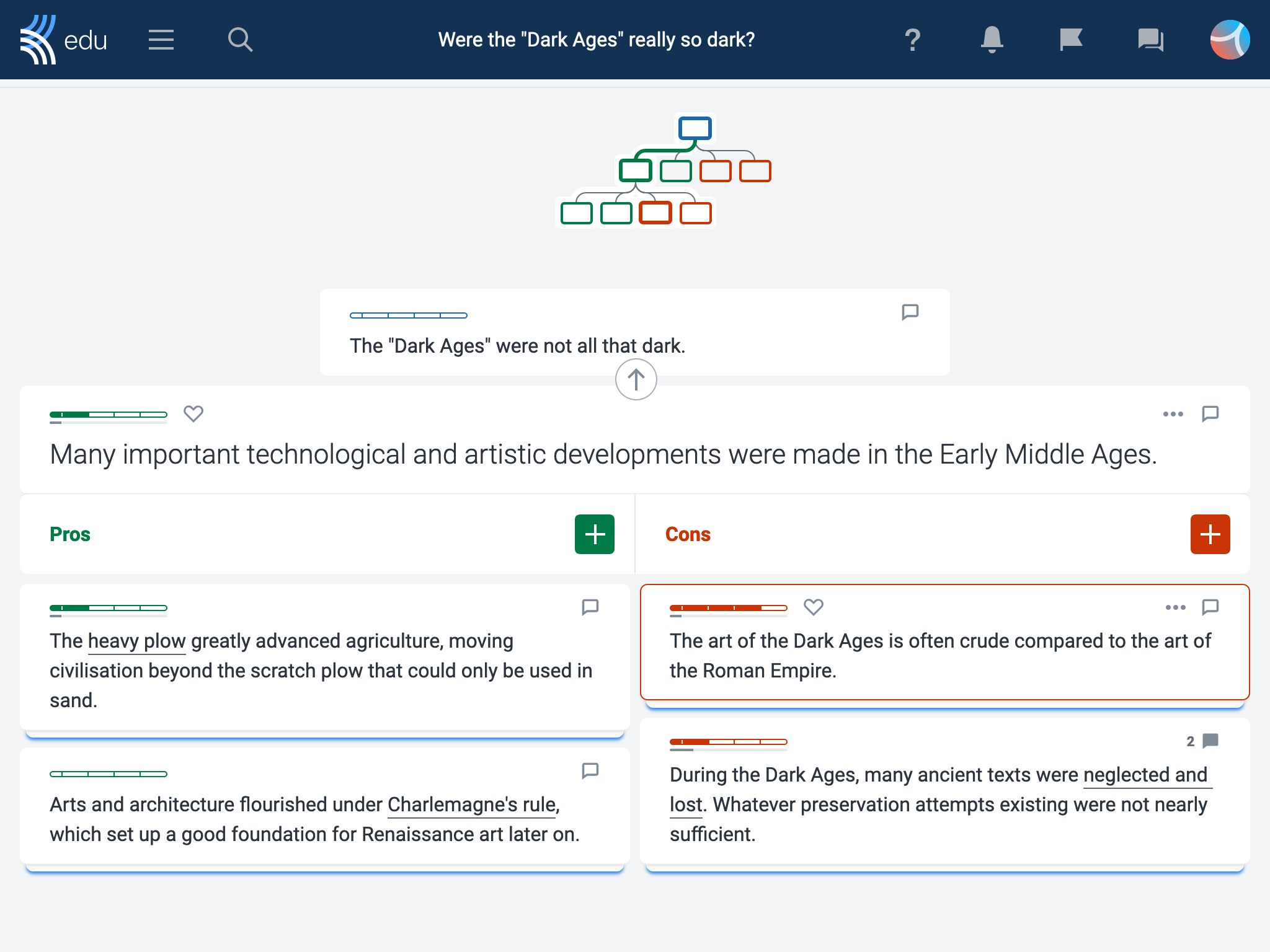
Moreover, Kialo discussions are an engaging way for students to work independently, or in collaboration with homeschooled peers and siblings, as parents or tutors can easily monitor and support student learning.
You can keep a record of student learning and exploration, handy for reviewing content covered if you don’t use textbooks. And importantly, Kialo discussions are easy to use, take seconds to set up, and are completely free!
How can I use Kialo Edu to reach learning goals in a homeschooling curriculum?
Here’s a broad overview of how you can fit Kialo discussions into your homeschooling curriculum. You can use Kialo discussions to demonstrate and support learning by using it to:
- Provide a structured approach to tracking students’ own projects.
- Fit discussions into learning portfolios.
- Facilitate collaborative learning with other homeschooled students.
- Record the research on curricular and non-curricular content.
- Explore new topics.
- Structure literary analysis and engagement.
- Act as an alternative to essays.
- Train key writing skills.
- Serve as a learning review tool.
- Give personalized assessment and feedback.
Below are some specific activities for you to try out!
Nine unique homeschooling activities and ideas with Kialo Edu
1. Use Kialo to bring homeschooled students together to collaborate
What it’s good for: to practice peer-to-peer interaction and collaborative learning

A discussion is a great way to collaborate with other homeschooled students while keeping them on task.
Create a discussion on a mutually agreed-upon topic and invite others in your learning network to participate. This may be a sibling at the same table or a friend in another town.
Students gain exposure to different perspectives to help them examine the strengths and weaknesses of their arguments, with discussion participants adding to (and pushing back on!) each other’s contributions. Plus, it’s a highly engaging way for students to collaborate — good news for your learning outcomes.
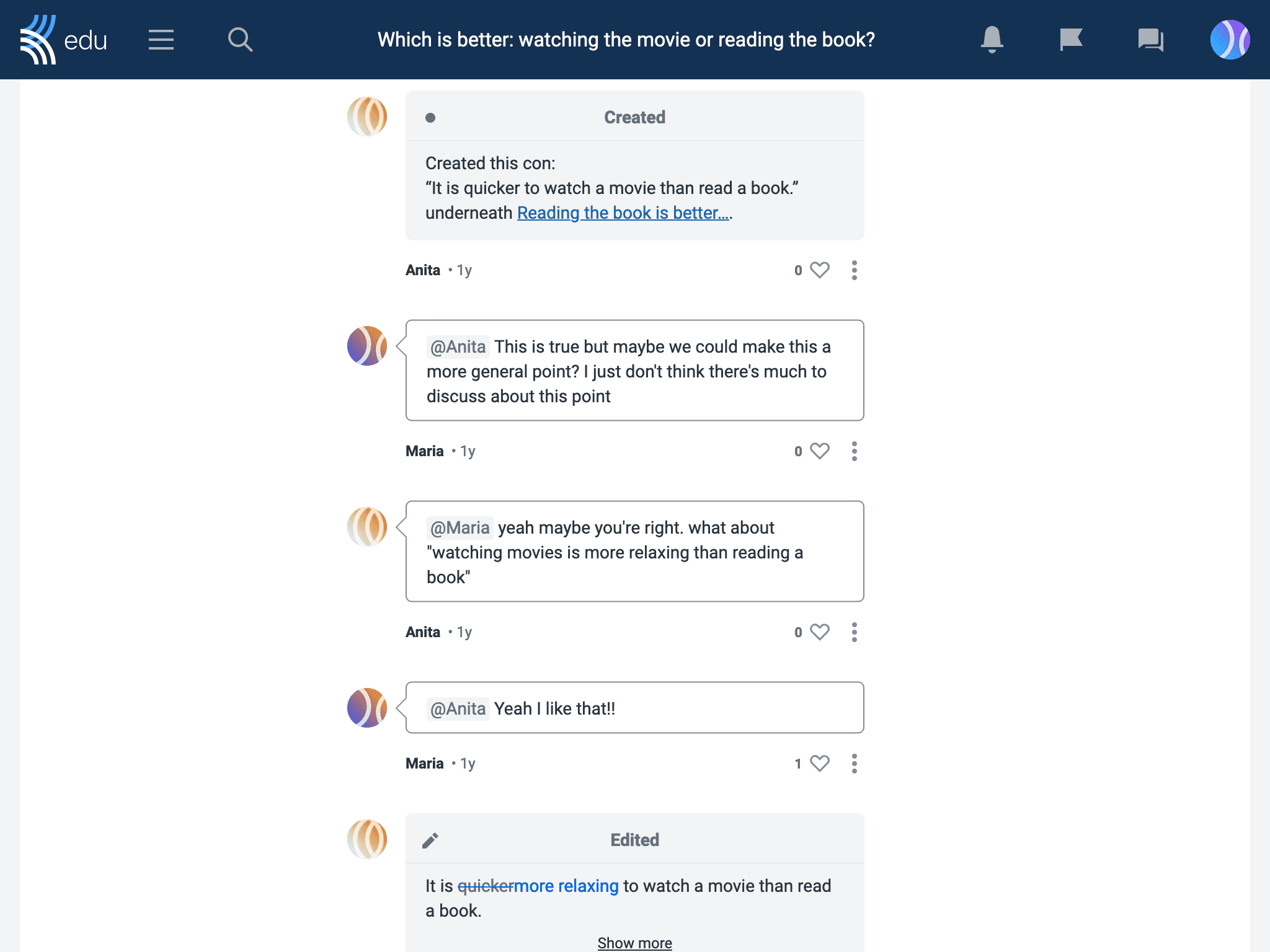
Students can contribute simultaneously or at a time that suits them, and communicate more informally right in the discussion by enabling the Discussion Chat. You might even form a homeschooling book or film club for students to engage with their peers’ opinions — which leads us to our next activity!
2. Use Kialo as an engaging (and educational!) way to start or break up a learning session
What it’s good for: to boost engagement, promote creativity, and foster a positive learning environment
Lighter icebreaker discussions act as a wonderful boost to get students motivated for learning on a cold morning, or as an uplifting reset between subjects. And whether your student is agonizing over the best superpower or arguing that a hotdog is a sandwich, they are still training their critical thinking and argumentation skills!
Discussions also foster creativity, one of the 21st-century skills for learning. A classic discussion on desert island survival, for instance, requires creative problem-solving to warm up your student’s creative muscles.
3. Use Kialo for literature or film analysis
What it’s good for: to develop analytical skills and enhance understanding of literature.
Use literature debate topics to have your student critically engage with their reading by analyzing the themes, characters, and the broader context in which the literature is set. If they need help getting started, try adding starter claims to the discussion to focus their efforts.
You might even find just what you need in our Topic Library which already has lots of ready-to-go literature templates from Shakespeare to the most popular science fiction/fantasy series. Younger fans of Charlie and the Chocolate Factory who are new to character analysis might enjoy exploring Willy Wonka’s motivations with you as their discussion partner!
4. Use Kialo to learn about a complex topic alongside your student
What it’s good for: to develop a deep understanding of a subject matter, encourage ownership of learning, and see lifelong learning in action
It’s normal to encounter complex topics in homeschooling that you are less than comfortable with teaching. Topics may include historical analysis, exploration of political systems, or questions of ethics in science and technology, to name a few. Whether such topics arise out of student interest or through a particular curriculum you are using, a Kialo discussion is a great way to tackle it alongside your student.
Ask your student to develop a question to explore a chosen topic. Generating questions empowers students to lead the way in their own learning. When a question triggers their curiosity, students are more invested in the outcome! They are prompted to seek out and analyze information rather than simply memorize presented content. This ultimately leads to a deeper understanding of the topic.
To encourage your student to take ownership of their learning, ask them to set up their own Kialo discussion from scratch. Encourage them to add a cover image, plan out their approach in the Background Info section, and even set their own objectives using Tasks. Have them invite you to the discussion so you can help them develop it, or offer praise on their insightful claims.
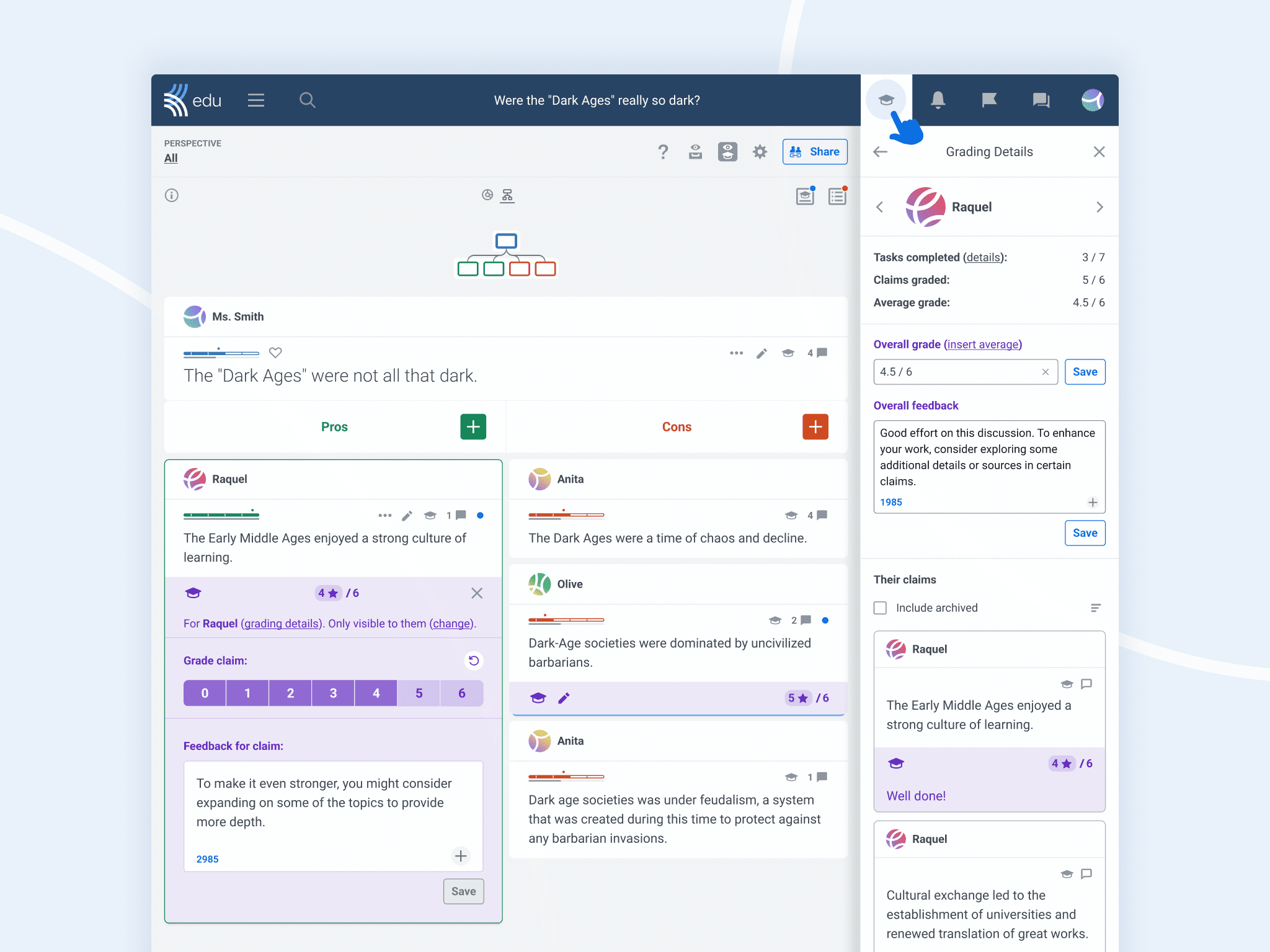
Then, work together to gather information on the topic through research, watching documentaries, going to libraries and museums, connecting with subject matter experts, or accessing online educational content.
Have students use the discussion to record their learning, explain their findings to you, and show how different claims link together. It’s easy to add, move, and edit claims as new knowledge is gained making the discussion a dynamic and reflective learning experience!
5. Use Kialo to analyze current events
What it’s good for: to develop political and media literacy skills and consider different perspectives
Current events often involve evolving and sensitive events, with competing interests and vocal opinions. Add in the real possibility of online misinformation and media bias, and it’s clear that students need critical thinking skills to empower them to form their own evidence-based conclusions.
In your homeschool learning environment, you can take the time to guide your students through prominent news headlines. Create a Kialo discussion to explore the background context and different views they may encounter. By using a range of articles, blogs, and reports, you can ensure your student reads widely while teaching them how to evaluate source reliability.
Students can even record their sources right in the discussion itself to back up their ideas. And since Kialo discussions are automatically saved, your student can pick them up again as new developments emerge.
To follow up, ask your student to write a news report, summarizing the information in their discussion. Prompt them to imagine their audience has no prior knowledge of the topic and that they need to both inform and evaluate the situation as it stands.
6. Use Kialo to apply curricular knowledge to problem-solving tasks and real-world contexts
What it’s good for: to make learning meaningful, develop problem-solving skills, and promote knowledge transfer across different contexts.
Solving an authentic, real-world issue or investigating a project is a great way to lift a subject out of a coursebook and get your student actively using their knowledge! A Kialo discussion provides a structured visual framework for students to externalize and organize their thoughts and ideas.
First, pose a problem and help your student get to the root of it, identifying just where the issues lie. Problems might be exploring how to ensure young people have a healthy lifestyle, or how to address the impact of pollution in their local area, for instance.
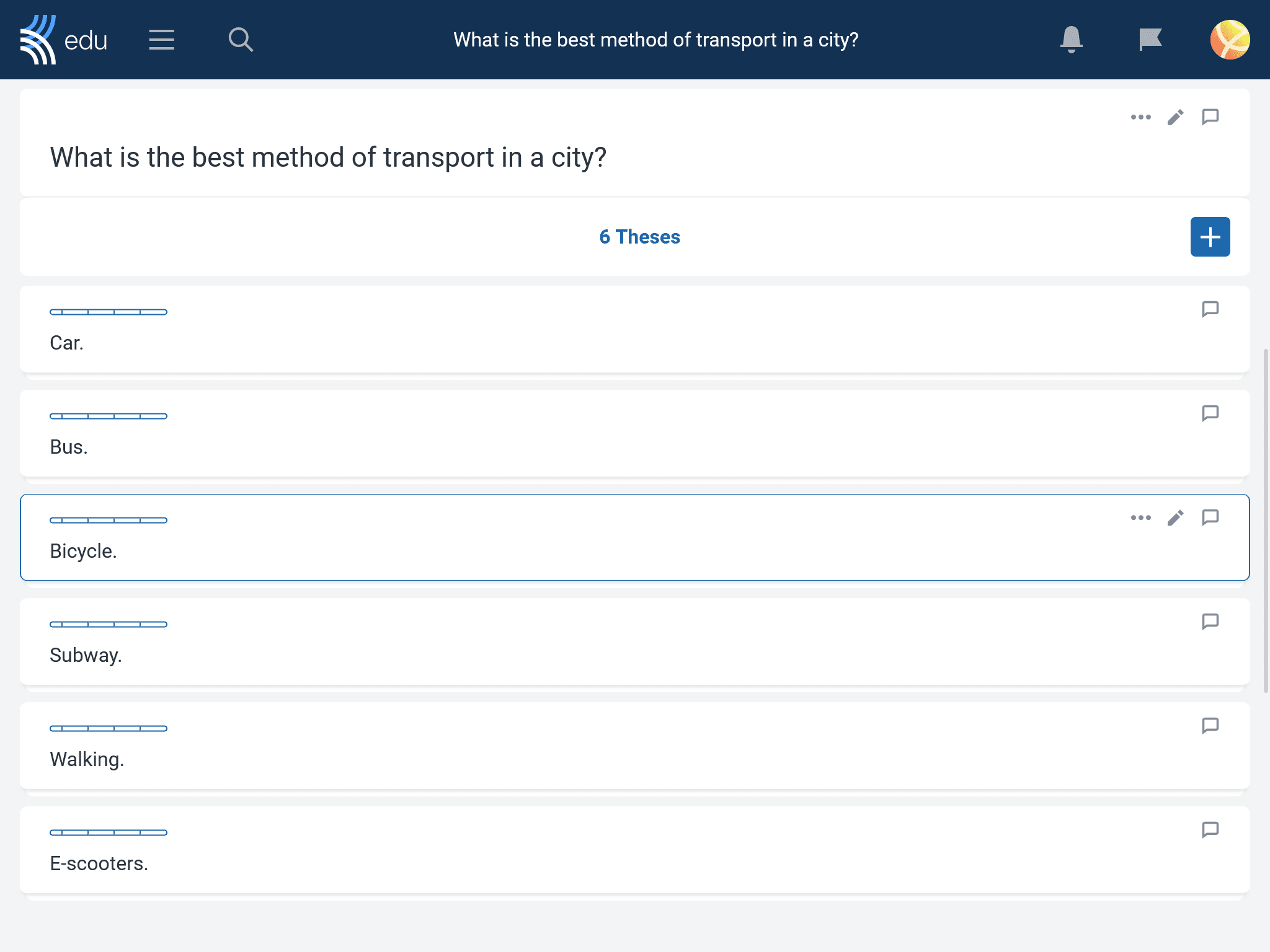
Then, task your student with brainstorming potential solutions, before narrowing them down to three or so. Set up a multi-thesis discussion to delve into each solution in detail. To follow up, ask your student to propose their preferred solution and persuade you of its potential! They might do this by creating a presentation, a speech, or a letter to key decision-makers.
7. Use Kialo as an essay alternative, prewriting activity, or to train writing skills
What’s it good for: to practice formulating arguments, citing sources, and writing clearly
Discussions can be a more approachable format than the traditional essay, or simply an engaging alternative to switch up writing practice! With Kialo, your student can train their reasoning skills with short, focused contributions that build into the bigger picture. A Kialo discussion is also an effective prewriting activity to scaffold a traditional essay. It helps ensure students clarify their thinking before rushing to put pen to paper!
The short-form format of claims means your student can practice key writing skills at sentence level while still building a coherent overall argument. Try setting goals for your student to direct their attention to areas they are still learning, such as using topic-specific vocabulary, practicing particular sentence structures, or abiding by accurate grammar.
You can also use Tasks to set expectations for a quantity of cited sources to encourage research skills. If your student is new to adding sources, provide them with options and support in incorporating them!
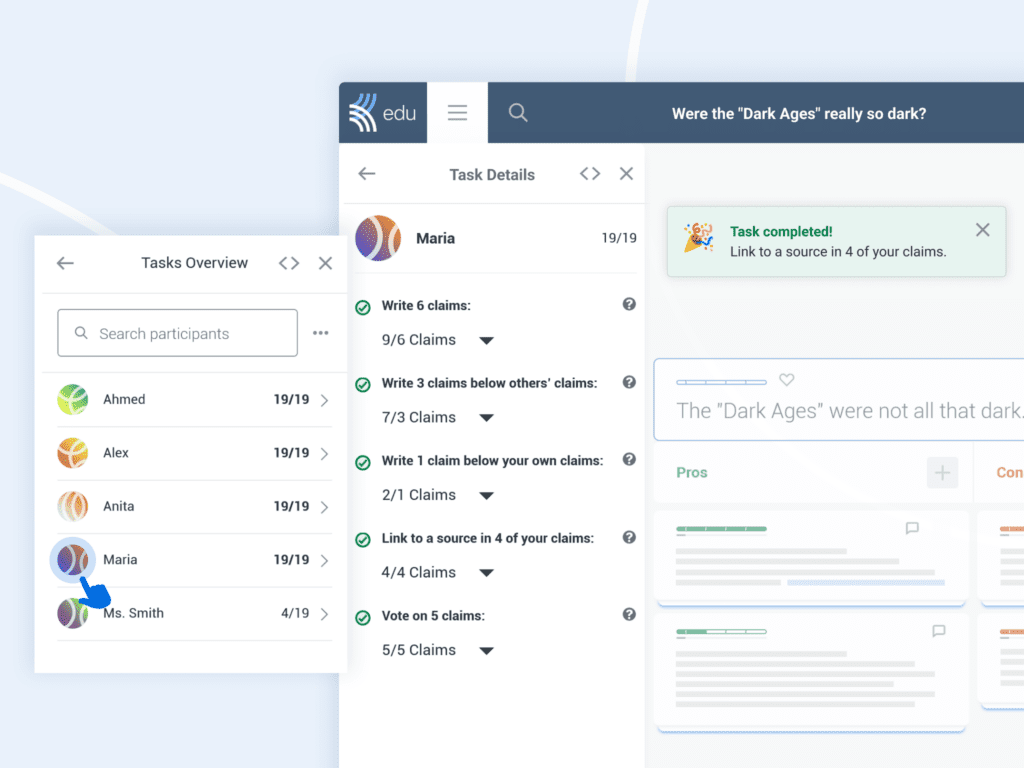
8. Use Kialo to maximize the benefits of field trips
What it’s good for: to reinforce learning experiences from excursion-based activities
Field trips offer a great opportunity for students to see academic concepts in real-world settings and often provide hands-on learning experiences. And of course, the change of scenery can be a welcome change of pace to a regular lesson!
You can use a Kialo discussion to formalize these learning experiences and demonstrate student engagement. Use a discussion before a field trip to prepare your student by giving them a knowledge base they can build on during their excursion. After the outing, have them return to their discussion to reflect on what they learned and add new insights gained.
Alternatively, create a discussion for deeper exploration of a question that arises from the outing. That way, if a particular element captures their attention, such as an interesting exhibit in a museum, your student can pursue it in more detail in subsequent classes!
9. Use Kialo to explore student interests in detail
What’s it good for: to increase student motivation and foster curiosity
Take advantage of a student’s motivation for their hobbies and personal interests to support learning. If a student is a passionate gamer, for instance, they may relish the opportunity to convince you that video games benefit learning or should be considered an art form. Sports fans might have strong opinions on penalty shootouts, while music lovers might enjoy a lesson exploring the purpose of music.
Weighing up the pros and cons in a discussion sees students anticipate counterarguments and develop their critical thinking and argumentation skills, all the while helping them further their interests!
Explore our blog for more ideas for integrating Kialo into your family’s educational journey! We’d love to hear about how you maximize the learning potential in your homeschooling environment. Please do get in touch at feedback@kialo-edu.com or on any of our social media platforms.

